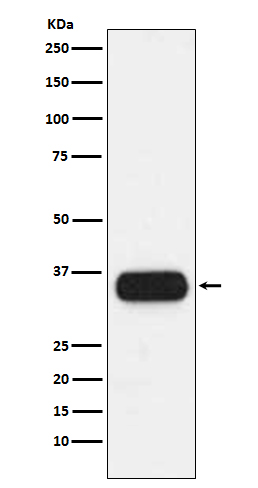
| WB | 咨询技术 | Human,Mouse,Rat |
| IF | 咨询技术 | Human,Mouse,Rat |
| IHC | 1/30-1/150 | Human,Mouse,Rat |
| ICC | 技术咨询 | Human,Mouse,Rat |
| FCM | 咨询技术 | Human,Mouse,Rat |
| Elisa | 1/2000-1/10000 | Human,Mouse,Rat |
| Aliases | HLA-DQA1; CD; CELIAC1; DQ-A1; GSE; HLA-DQA; DQ alpha 1 chain; DC-1 alpha chain; DC-alpha; HLA-DCA; MHC class II DQA1;;HLA DQA1 |
| WB Predicted band size | 28 kDa |
| Host/Isotype | Rabbit IgG |
| Antibody Type | Primary antibody |
| Storage | Store at 4°C short term. Aliquot and store at -20°C long term. Avoid freeze/thaw cycles. |
| Species Reactivity | Human,Mouse,Rat |
| Immunogen | A synthesized peptide derived from human HLA DQA1 |
| Formulation | Purified antibody in PBS with 0.05% sodium azide,0.05% BSA and 50% glycerol. |
+ +
以下是关于FUS抗体的3篇参考文献的简要总结:
---
1. **文献名称**:*Mutations in FUS cause familial amyotrophic lateral sclerosis via protein aggregation*
**作者**:Neumann, M., et al.
**摘要**:该研究通过免疫组化分析发现,携带FUS基因突变的ALS患者神经元中存在异常蛋白聚集。研究使用特异性FUS抗体证实突变导致FUS从细胞核错误定位至细胞质,并形成病理性包涵体。
2. **文献名称**:*ALS-associated fused in sarcoma (FUS) mutations disrupt Transportin-mediated nuclear import*
**作者**:Dormann, D., et al.
**摘要**:文章探讨FUS突变如何破坏其核定位机制。通过多种FUS抗体进行免疫荧光和Western blot,发现突变体因与核转运蛋白Transportin结合受损而在胞质累积,强调了抗体在亚细胞定位研究中的关键作用。
3. **文献名称**:*Divergent roles of ALS-linked proteins FUS/TLS and TDP-43 intersect in processing long pre-mRNAs*
**作者**:Lagier-Tourenne, C., et al.
**摘要**:研究比较了FUS和TDP-43在RNA代谢中的功能差异,利用FUS抗体进行免疫沉淀和染色,发现二者均参与长转录本RNA的加工,但突变FUS通过抗体检测显示其异常聚集与RNA剪接缺陷相关。
---
这些文献均通过FUS抗体揭示了该蛋白在疾病中的病理机制或功能特性,涵盖定位异常、核转运缺陷及RNA代谢研究。
FUS (Fused in Sarcoma) antibodies are essential tools in studying the FUS protein, a multifunctional RNA-binding protein encoded by the *FUS* gene. FUS belongs to the TET family of proteins involved in RNA metabolism, including transcription, splicing, transport, and stability. It plays critical roles in neuronal development, DNA repair, and stress response. Dysregulation of FUS is linked to neurodegenerative diseases, particularly amyotrophic lateral sclerosis (ALS) and frontotemporal lobar degeneration (FTLD), where mutations or abnormal cytoplasmic accumulation of FUS are observed. Additionally, FUS is implicated in certain cancers, such as sarcomas, due to chromosomal translocations.
FUS antibodies are widely used in research to detect FUS expression, localization, and post-translational modifications. They enable techniques like Western blotting, immunohistochemistry (IHC), and immunofluorescence (IF) to study pathological aggregates in ALS/FTLD patient tissues or cell models. Monoclonal and polyclonal antibodies targeting specific FUS epitopes help differentiate between normal nuclear FUS and mislocalized cytoplasmic forms. Validating antibody specificity is crucial, as cross-reactivity with related proteins (e.g., EWSR1 or TAF15) can lead to false interpretations. Recent studies also explore FUS's role in liquid-liquid phase separation and stress granule dynamics, further driving demand for high-quality antibodies. Overall, FUS antibodies are pivotal in unraveling the protein’s physiological functions and its contribution to disease mechanisms.
×